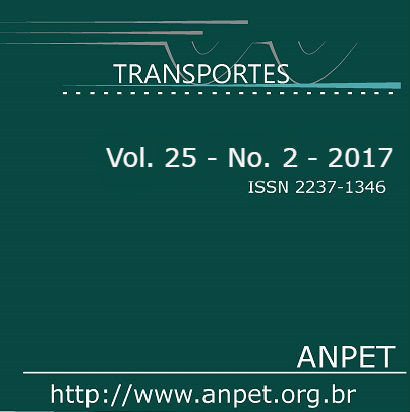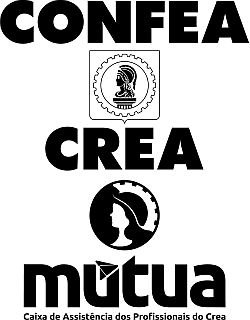Conceito, configuração e aplicação de um simulador de direção no Brasil – Estudo de caso
DOI:
https://doi.org/10.14295/transportes.v25i2.1174Palavras-chave:
Simulador de direção, Segurança viária, Análise estatística, Comportamento condutor.Resumo
Desde 2011, o mundo vive a Década de Ação para a Segurança Rodoviária (2011-2020) cujo objetivo é reduzir pela metade o número de vítimas de acidentes de trânsito. Simuladores de condução podem ajudar nos estudos sobre segurança viária sem oferecer risco aos voluntários e pesquisadores. O presente artigo descreve um simulador de médios porte e custo, utilizado principalmente por indústrias automotivas. Tais simuladores têm sido utilizados em diversas aplicações como estudos do comportamento de condutores, projeto geométrico de vias e sinalizações horizontal e vertical da pista. O simulador descrito possui características e desempenho similares ao de um veículo compacto real e os programas utilizados para compilação dos dados de entrada trabalham em tempo real. Dois estudos conduzidos no simulador são apresentados de forma sucinta: o primeiro analisa a percepção dos condutores com relação à sinalização de um trecho de rodovia brasileira e o segundo avalia a alteração da capacidade cognitiva de um condutor quando submetido a uma tarefa secundária à da condução.
Downloads
Referências
Ahlström, C., Dukic, T., IvarssoN, E., Kircher, A., Rydbeck, B., Viström, M. (2010). Performance of a one-camera and a three cam-era system: ViP publication. Disponível em: <http://smarteye.se/wp-content/uploads/2015/01/Ahlstrom-Christer-et.-al..pdf>.
Balci, O. (1994). Validation, verification, and testing techniques throughout the life cycle of a simulation study. Annals of Oper-ations Research, v. 53, n. 1-4, p. 121-173. DOI: 10.1007/BF02136828
Bella, F. (2007). Parameters for evaluation of speed differential: contribution using driving simulator. transportation re-search record. Journal of the Transportation Research Board, v. 2023, p. 37-43. DOI: 10.3141/2023-05.
Bella, F.; Calvi, A. (2013). Effects of simulated day and night driving on the speed differential in tangent–curve transition: a pilot study using driving simulator. Traffic Injury Prevention, v. 14, n. 4, p. 413-423. DOI: 10.1080/15389588.2012.716880.
Blana, E. (1996a). Driving simulator validation studies: a literature review leeds. UK: Institute of Transport Studies, University of Leeds, Working Paper 480. Disponível em: < http://eprints.whiterose.ac.uk/2111/ >.
Blana, E. (1996b). A survey of driving research simulators around the world. UK: Institute of Transport Studies, University of Leeds, Working Paper 481. Disponível em: < http://eprints.whiterose.ac.uk/2110/ >
Boyle, L. N. e J. D. Lee (2010). Using driving simulators to assess driving safety. Accident Analysis and Prevention, v 42, p 787–788. DOI: 10.1016/j.aap.2010.03.006.
Broughton, K. L.; Switzer, F.; Scott, D. (2007). Car following decisions under three visibility conditions and two speeds tested with a driving simulator. Accident Analysis & Prevention, v. 39, n. 1, p. 106-116. DOI: 10.1016/j.aap.2006.06.009.
Costa Neto, A. (1992). Application of multibody system techniques to automotive vehicle chassis simulation for motion control studies. Tese (Doutorado em Engenharia Mecânica) – University of Warwick. Disponível em: < https://www.resear chgate.net/publication/266315563_Application_of_Multibody_Systems_Techniques_to_Automotive_Vehicle_Chassis_Simulation_for_Motion_Control_Studies>
Duchowski, A. (2007). Eye tracking methodology, theory and practice. 2 ed. Londres: Springer. DOI: 10.1007/978-1-84628-609-4.
Devlin, A. et al. (2012). Investigating driving behaviour of older drivers with mild cognitive impairment using a portable driving simulator. Accident Analysis & Prevention, v. 49, p. 300-307, 11. DOI: 10.1016/j.aap.2012.02.022.
Evgenikos, P. et al. (2010). WHO | Data systems: a road safety manual for decision-makers and practitioners. WHO. Disponível em: < http://www.who.int/roadsafety/projects/manual/data/en/>.
Filtness, A. J. et al. (2017). Sleep‐related eye symptoms and their potential for identifying driver sleepiness. Journal of Sleep Research, v. 23, n. 5, p. 568-575. DOI: 10.1111/jsr.12163.
Fernandes, C. G. (2009). Método probabilístico para o estudo de sistemas dinâmicos não-lineares: uma aplicação em dinâmica veicular. Tese (Doutorado em Engenharia Naval e Oceânica) - Escola Politécnica, Universidade de São Paulo. DOI: 10.11606/T.3.2009.tde-21122009-133620.
Fisher, D. L. et al (2011). Handbook of driving simulation for engineering, medicine, and psychology. Boca Raton, USA: CRC Press.
Godley, S. T.; Triggs, T. J.; Fildes, B. N. (2002). Driving simulator validation for speed research. Accident Analysis & Prevention, v. 34, n. 5, p. 589-600, 9. DOI: 10.1016/S0001-4575(01)00056-2.
Greenberg, J. B. (2011). Physical fidelity of driving simulators. In; Fisher, D. I. et al. Handbook of driving simulation for engi-neering, medicine, and psychology. Boca Raton, USA: CRC Press.
Helland, A. et al. (2013). Comparison of driving simulator performance with real driving after alcohol intake: A randomized, single blind, placebo-controlled, cross-over trial. Accident Analysis and Prevention, v 53, p 9–16. DOI: 10.1016/j.aap.2012.12.042.
Jamson, S; Lai, F.; Jamson, H. (2010). Driving simulator for robust comparisons: a case study evaluating road safety engineer-ing treatments. Accident Analysis and Prevention, v 42, n. 3, p 961–971. DOI: 10.1016/j.aap.2009.04.014.
Källhammer, J.-E. et al. (2007). Shouldn’t cars react as drivers expect?, Proceedings of the fourth international driving symposi-um on human factors in driver assessment, training and vehicle design. autoliv research. Vårgårda, Sweden, 2007. Disponível em: < https://www.researchgate.net/profile/Jan-Erik_Kaellhammer/publication/242150024_SHOULDN'T_CARS_REACT_AS_DRIVERS_EXPECT/links/00b4951d5db1e8ad5f000000.pdf >
Kemeny, A.; Panerai, F. (2003). Evaluating perception in driving simulation experiments. Trends in Cognitive Sciences, v. 7, n. 1, p. 31-37. DOI: 10.1016/S1364-6613(02)00011-6.
Knapper, A. Christoph, M., Hagenzieker, M., Brookhuis, K. (2015) Comparing a driving simulator to the real road regarding distracted driving speed. European Journal of Transport and Infrastructure Research, v. 2, n. 15, p. 205-225. Disponível em: < http://repository.tudelft.nl/islandora/object/uuid:de0f6373-5856-45bc-9af4-fa74c6521997?collection=research>.
Lee, H.C.; Cameron, D.; Lee, A. H. (2003). Assessing the driving performance of older adult drivers: on-road versus simulated driving. Accident Analysis & Prevention, v. 35, n. 5, p. 797-803. DOI: 10.1016/S0001-4575(02)00083-0.
Rangel, M.A.C. (2015). Análise da percepção da sinalização vertical por parte do condutor, utilizando ambientes simulados de dire-ção: um estudo de caso na rodovia BR-116. Dissertação (Mestrado em Engenharia de Transporte e Infraestrutura de Transportes) - Escola de Engenharia São Carlos, Universidade de São Paulo. DOI: 10.11606/D.18.2015.tde-29072015-101734.
Reymond, G. et al. (2001). Role of lateral acceleration in curve driving: driver model and experiments on a real vehicle and a driving simulator. Human Factors, v. 43, n. 3, p. 483-495. DOI: 10.1518/001872001775898188.
Rumschlag, G. et al. (2015). The effects of texting on driving performance in a driving simulator: the influence of driver age. Accident Analysis & Prevention, v. 74, n. 6, p. 145-149. DOI: 10.1016/j.aap.2014.10.009.
Törnros, J. (1998). Driving behaviour in a real and a simulated road tunnel: a validation study. Accident Analysis & Prevention, v. 30, n. 4, p. 497-503, 7. DOI: 10.1016/S0001-4575(97)00099-7.
Underwood, G.; Crundall; D., Chapman, P. (2011). Driving simulator validation with hazard perception. Transportation Re-search Part F: Traffic Psychology and Behavior, v. 14, n. 6, p. 435-446. DOI: 10.1016/j.trf.2011.04.008.
Vieira, F. S. et al. (2015). Análise da fixação ocular de condutores através de teste de carga mental. XXIX Congresso Nacional de Pesquisa em Transporte da ANPET – Ouro Preto / MG, 2015. Disponível em: < http://www.anpet.org.br/xxixanpet/anais/documents/AC838.pdf >.
WHO | World Health Organization (2015). Global status report on road safety: time for action. Geneva: WHO. Disponível em: <http://www.who.int/violence_injury_prevention/road_safety_status/2015/en/>. Acesso em 16 jul. 2015.
Yan, X. et al. (2008) Validating a driving simulator using surrogate safety measures. Accident Analysis & Prevention, v. 40, n. 1, p. 274-288. DOI: 10.1016/j.trf.2011.04.008.
Downloads
Publicado
Como Citar
Edição
Seção
Licença
Ao submeter um manuscrito para publicação neste periódico, todos os seus autores concordam, antecipada e irrestritamente, com os seguintes termos:
- Os autores mantém os direitos autorais e concedem à Transportes o direito de primeira publicação do manuscrito, sem nenhum ônus financeiro, e abrem mão de qualquer outra remuneração pela sua publicação pela ANPET.
- Ao ser publicado pela Transportes, o manuscrito fica automaticamente licenciado sob a Licença Creative Commons CC BY 4.0. Esta licença permite o seu compartilhamento com reconhecimento da autoria e da publicação inicial neste periódico.
- Os autores têm autorização para assumir contratos adicionais separadamente, para distribuição não exclusiva da versão do trabalho publicada neste periódico (por ex.: publicar em repositório institucional ou como capítulo de livro), com reconhecimento da publicação inicial na Transportes, desde que tal contrato não implique num endosso do conteúdo do manuscrito ou do novo veículo pela ANPET.
- Os autores têm permissão e são estimulados a publicar e distribuir seu manuscrito online (por ex.: em repositórios institucionais ou na sua página pessoal) depois de concluído o processo editorial. Como a Transportes é de acesso livre, os autores são estimulados a usar links para o DOI do artigo nesses casos.
- Os autores garantem que obtiveram todas as permissões necessárias dos empregadores para a publicação e o licenciamento CC BY 4.0 do manuscrito, especialmente se o empregador possuir alguma reivindicação sobre os direitos autorais do manuscrito. Os autores assumem total responsabilidade por questões de direitos autorais relacionadas ao empregador, isentando a ANPET e a Transportes de qualquer responsabilidade relacionada.
- Os autores assumem toda responsabilidade sobre o conteúdo do manuscrito, incluindo as devidas e necessárias autorizações para divulgação de dados coletados e resultados obtidos, isentando a ANPET e a Transportes de toda e qualquer responsabilidade neste sentido.
Última atualização: 27/11/2025











